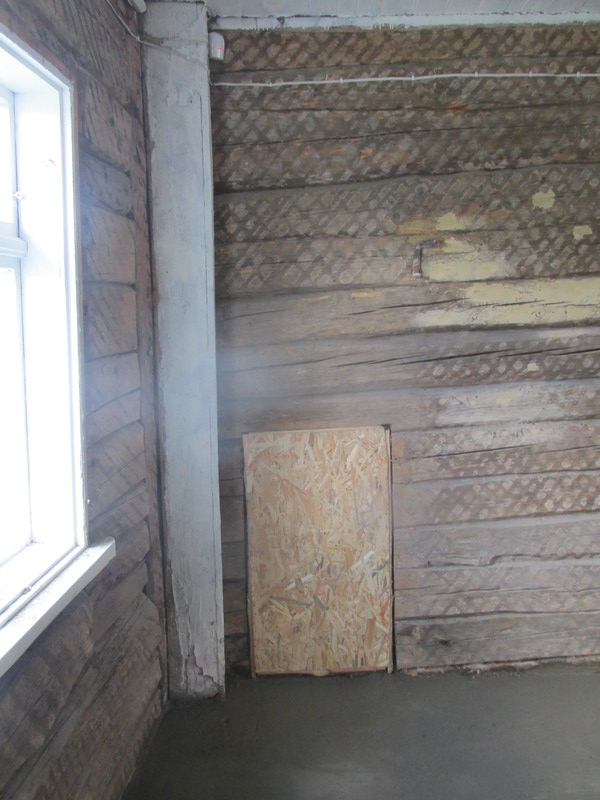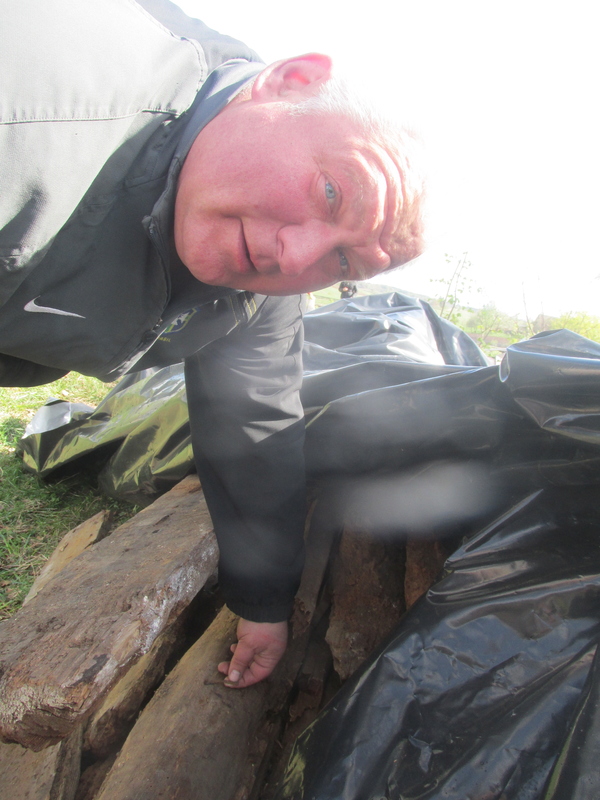E Y E W I T N E S S R E P O R T / O P I N I O N
by Andrius Kulikauskas
◊

Renovation of the ground floor of an art gallery in the town of Butrimonys, Lithuania has revealed the existence of an unusual cellar that was apparently a Jewish hideout during the Holocaust. Daina Nemeikštienė, the owner of the gallery, “Dainos galerija”, is moving forward with the renovation, which means that what remains of the cellar will be cemented over, at least for now. Could some day this hideout offer an opportunity for respecting, valuing, studying, preserving and highlighting Litvak and Lithuanian heritage? For now, it illustrates the challenges in honoring even the most heroic aspects of the Holocaust.
Daina Nemeikštienė, originally from Plungė, saw the home at Vilniaus g. 1 in Butrimonys for sale in 2003. She purchased it and transformed it into an art gallery. She’s adorned the floor and walls with fragments of colorful ceramic tile. Butrimonys is a rare town in Lithuania to have a private art center. It is open during town celebrations such as Sekminės and features local artists from the Alytus region including Kostas Poškus and Algirdas Judickas. Daina’s brother Darius Miliauskas is a sculptor and stoneworker who lived in Ireland for a decade. He returned to Lithuania in 2013 and now has a heraldry studio and sculpture garden at his sister Daina’s gallery.
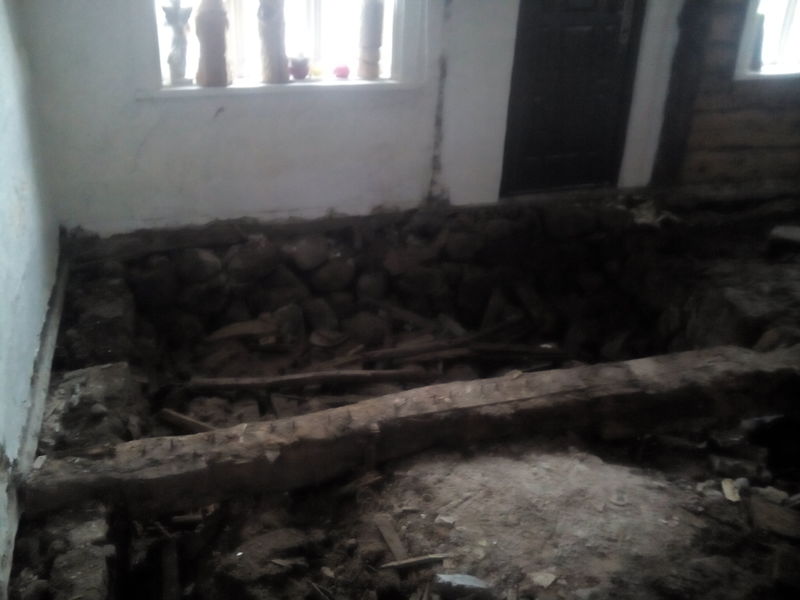
Darius was struck by the unusual cellar that was exposed when the floor boards were lifted. The square cover for the hole into the cellar was positioned right by the house’s front door, perhaps the least likely place anybody might look for it. The space was 2.5 meters long by 2 meters wide and about 0.5 meters deep, although it might have been deeper at some point. Certainly one or more people could lie there hiding.

Darius noted the handmade nails which were designed to be impossible to pull out as they were thicker at the pointy end and the heads lacked lips. Darius called me on Monday, April 20, urging me to rush over and help convince his sister Daina to halt the renovations. Darius was quite frustrated in his attempts to talk with Daina on this subject. I spoke with Dovid Katz and he confirmed that there would be real interest in a possible “malina” (Yiddish malíne) as such a hideout was called in the Holocaust years, adding with a touch of Litvak skepticism that we’d need to find some really solid evidence, and if that wasn’t to be found at the site, perhaps there might be a mention in one of the Holocaust memoirs relating to the town, or someone still alive might remember the original depth of the cellar right after the war. Darius sent me the photographs above which he made with his cellphone.

I live in the nearby village of Eičiūnai, about five kilometers away, but at the time I was in Vilnius. On Thursday, April 23, my friend Rimas Morkūnas and I drove out and Darius showed us what was left of the hideout. His sister Daina had made her workers take out the beam and fill in the cellar with bricks and rubble. Rimas and I agreed that it certainly seemed like a hideout. Rimas is the director of the film Conversations at Midnight about Vladas Drupas, a young man who saved Jews in Šiauliai.
I noted that the cellar was located next to a stone wall that faced out onto the town square. There may very well have been a gap in the wall through which a person could hear what was happening out in the square.
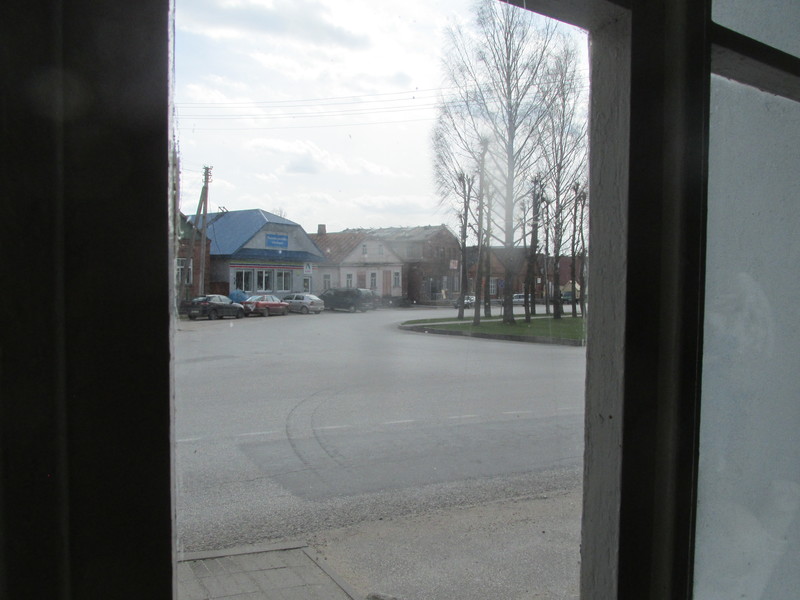
It might have even been possible to observe the two story building which Leonardas Kaspariūnas turned into the city hall and a center for perpetrating the Holocaust. As Holocaust survivor Riva Lozansky related in her memoirs, Kaspariūnas was a Lithuanian army officer who during the first Soviet occupation (1940-1941) became a Communist Party member and then during the Nazi-occupation served as chief of police.
Darius also noted a small door not quite one meter tall that connected this front room with a room further back, as if to aid an escape into the back of the house and out the yard, we imagined.
Rimas offered the idea of putting in a glass floor above the cellar as a way to keep the hideout visible. This idea intrigued Daina when I spoke with her by phone. She agreed to wait so that I could get more signs of potential interest as well as options of what to do. Finally, I was able to visit her on Sunday afternoon, April 26.
Daina encouraged me to wait and talk with her friends on their way from Kaunas, her cousin Rita and her husband Artūras, a structural engineer. Daina, always friendly, offered me some chicken. Meanwhile, two of her workers were sawing boards in the yard with a chainsaw. She was using the best of the boards to make raised garden beds on stilts, mini greenhouses, that might also serve somehow as a fence to keep the dog in.
We talked about the hideout. Dovid Katz had suggested that we in Butrimonys could write a proposal for a suitable foundation that might take interest in preserving the hideout. We would need to provide solid motivation and write up a reasonable budget. I thought this could be a great opportunity to host a meeting of local residents, especially those who own the six or seven stores in Butrimonys, so as to encourage us to value and share our Jewish heritage. In the 1897 census, there had been 1,919 Jews in Butrimonys, 80% of the population. There had been some fifty Jewish stores. I also imagined an art project whereby posters could be made for each building with their histories along with photographs of the Jewish inhabitants. Dovid encouraged me to get in touch with Rachel Kostanian of the Green House in Vilnius. The Jewish museum, of which the Green House is one component, had once presented an exhibit of many photographs from Butrimonys. We could ask that these photographs be displayed at Daina’s art gallery. Dovid would gladly post an article about the hideout at the DefendingHistory.com website. He also thought the Jewish museum in Vilnius might perhaps agree to donate the panels of its old exhibit to a permanent site in Butrimonys. We thought of approaching, for example, the Jakovas Bunka Charity and Sponsorship Fund. Jakovas Bunka was a folk artist, “the last Jew in Plungė” (in Yiddish: Plungyán), who memorialized the lost Litvak world. The fund in his name originally focused on Plungė but now takes up causes throughout Lithuania. Daina and Darius’s home town happens to be Plungė.
I had suggested to Dovid that this was an opportunity to contact Emanuelis Zingeris of the Seimas and “the commission” (to investigate the crimes of the Nazi and Soviet regimes), and his brother Markas Zingeris, head of the state Jewish museum. But Dovid resisted this idea, saying that much as he respected the brothers, they would make this political, and turn this into an example of Lithuania caring for its Holocaust past while, in Dovid’s view, continuing to support “Double Genocide” via the Prague Declaration and the commission. But I like to build bridges where they seem lacking. Indeed, in writing my article “How Did Lithuanians Wrong Litvaks?” I had kept in touch with historians Arūnas Bubnys and Saulius Sužiedėlis, active in the commission, who had privately been helpful. Recently, at the April 17, 2015 conference on Holocaust education in Vilnius city hall, Saulius Sužiedėlis pointed to a timeline of the 1941 killings listed by the Jaeger report and named Lithuanian Security Police chief Vytautas Reivytis as one of the worst perpetrators of the Holocaust in Lithuania, much as I did in my article. In response to my question about the Lithuanian Nationalist Party, and the Voldemarist coup, which placed Reivytis in power, Saulius stated publicly that my article (published at DefendingHistory.com) was a very valuable article (“labai vertingas straipsnis”) and that the LNP was an organized group of criminals (“organizuota nusikaltėlių grupė”) which neo-Nazis like Mindaugas Murza were praising as an exemplary party. However, neither Emanuelis nor Markas ever responded to my article, which I had personally given them for comment. Whereas Dovid had published my article and was ever supportive of my wish for friendship between Litvaks and Lithuanians.
Dovid said that a possible newly formed group which I might approach was a recently announced new commission on Jewish heritage. In a few weeks, they will meet for the first time. There are rumors that Sam Gruber, the Jewish art and architecture expert and a renowned champion of preservation of Jewish monuments worldwide, is a member.
Writing proposals is a job I hate, as does Audronė Anušauskienė, my neighbor and fellow independent thinker (“šviesuolis” — person of the light), who is better at winning than I am. She declined to get involved, although she has grown very appreciative of my quest to face up to Lithuanian atrocities in the Holocaust, to reach out to Litvaks and seek out a new friendship. Funders twist a moral opportunity for themselves to get involved into their own disinterested judgement of the fundee’s merit. Truly moral people find proposal writing demoralizing and gain nothing but grief, hurt and insult.
I had learned from the Internet that glass floors were expensive, about 3,000 euros per square meter. Furthermore, they could be scratched, for example, if shoes had sand on them. This was discouraging. But this was a chance for people to help. We could approach Father Juozas Bakšys of the Roman Catholic church in Butrimonys. I had mentioned to him the Holocaust, Lithuanian atrocities, my article and the hideout on Saturday while on a pilgrimage by foot from Alytus to Pivašiūnai. He had given me his email. Butrimonys was not a wealthy parish. But this was a chance for Roman Catholics across Lithuania to show that we cared about the heritage of those we had not cared about earlier.
Daina told me the history of the house. It was about two hundred years old. It had once belonged to a scissor man (žirklininkas) who had a sewing shop. An old lady Marytė, who was still alive but no longer able to speak, had told Daina that a Jewish couple had lived there after the war, apparently having survived the Holocaust. Then some Lithuanian teachers had lived there. They may well have filled the cellar with dirt and rubble, perhaps to keep it from caving in. Nobody had lived in the house for some ten years before Daina bought it.
Daina was aware of Bernard Berenson, the leading Renaissance art historian who hailed from Butrimonys (known to Litvaks as the shtetl Butrimánts). Bernard’s sister Senda Berenson Abott was the founder of women’s basketball. Nevertheless, Daina said that Jews don’t come to Butrimonys. I said that finding the hideout was a great stroke of luck for her art gallery. She had a great piece of heritage, both Litvak and Lithuanian. She could engage and inspire her neighbors to learn and present the history of the people who had lived and worked where they now did. Jews might come if we cared about them, if they felt welcome. Her art gallery thrived on her ability with art to make Butrimonys relevant to us and others, to Lithuanians, to Litvaks, to the whole world. Butrimonys was a Jewish town, by heritage. Without Jews, it felt haunted, rootless, restless, like I imagined Kaliningrad.
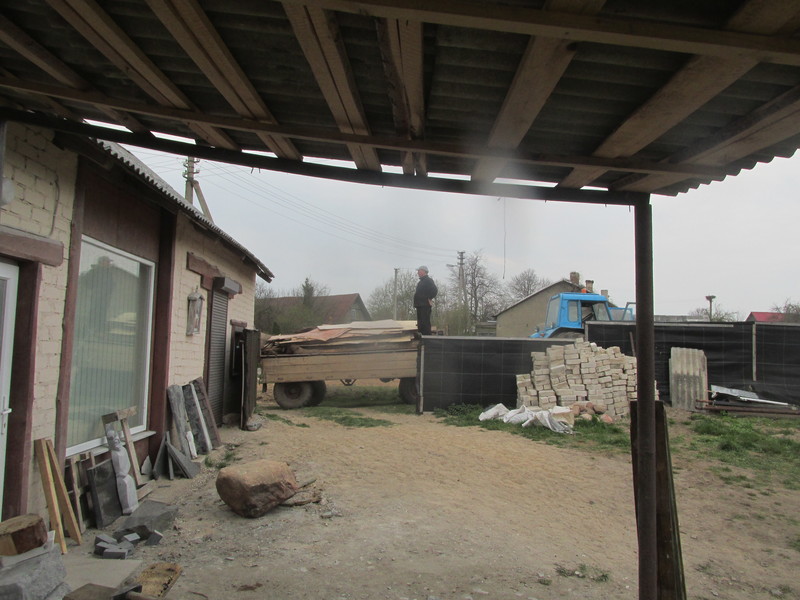
I was hoping that Daina would wait to see if the hideout might interest others. Meanwhile, the chainsaw was blazing through the boards piled up in back of her house. These boards had been taken from the first (ground) floor as well as the second floor. There were also large beams that had been part of the cellar. The boards were being sawed up for her garden beds and for firewood. I now understood Darius’s urgency that I take the boards for myself. I offered to buy the wood from Daina, I begged her to stop. I explained that I would use it for an art project, even the sawed up pieces. I realized that I had to act right away. I called a dozen people but couldn’t reach anybody. Finally, my neighbor Vytas Remeškevičius agreed to come with his tractor and trailer. Three young workers who helped me in Eičiūnai — Marius Vinskas, Mantas Dedelė and Virgis Beniušis — were willing to come help load. We normally don’t work on Sunday, but this was special. However, it took about an hour to organize a ride for them. Daina and I had discussed the young men digging out the rubble her workers had filled the cellar with. Darius, who was away, had been interested to dig out the cellar further to learn more. I tried to entice Daina that they might even find gold there, or more simply, historical artifacts. But it was growing clear that Daina wasn’t going to pursue this. She was trying to get the house presentable to welcome some women from Iceland who would be coming in a few weeks. Daina was glad that I could get the boards out of her yard. She said that whatever I would pay for them would be between Darius and me.

My youth came to load just as Artūras and Rita arrived from Kaunas. Artūras was skeptical of the need to preserve the hideout. Why not just put up a certificate that there had been a hideout here? I said that the hideout under our feet was a shrine. Imagine how you would feel if it had been a hideout for Lithuanian partisans. It made the history real and heroic. Even a child could imagine laying there, hiding there. But what is truly known about the building? I said that history teacher Danutė Anušauskienė had founded a museum in Butrimonys. For decades she had collected information about Jewish life there, including lists of addresses, who lived where. However, I said, ultimately it didn’t matter. If we didn’t know, then we could surely suppose, given what we knew of the times. It was fair and right for us to apply our imagination. History was a matter of creating the best legends, the ones that helped us grow morally and that were ever tested by whatever we can learn about the truth. Artūras disagreed deeply. He said that history was the facts. Later I explained myself that, factually, there was no such thing as the Lithuanian nation. There was nothing in our DNA that made us Lithuanian. The Lithuanian people, like all people, was an invention. This helped him understand me.
Daina was concerned about a crack in the wall. Artūras pointed out the large rocks that formed the wall of the cellar. If the cellar is dug out, then the rocks will cave inward. They need to be supported. The thing to do is to cover everything with gravel and thus preserve it. Then cement can be poured on top.
As my team and I finished loading, I noticed the cover to the cellar. You would want to keep that, I told Daina. She didn’t seem interested. She agreed that I could have it. So I ended up with the most tangible evidence of the hideout. I now had a trailer full of Jewish heritage for my village home. Well, lots of dry wall that Daina had put in, dozens of floor boards from before World War II, and a few giant beams that I suppose were as old as the house.
I paid 30 euros for Vytas and the tractor, 20 euros for Greta to taxi the young workers, and 30 euros for their work. I also offered 100 euros to Darius for all the wood.
So now I am the one who will be needing advice.
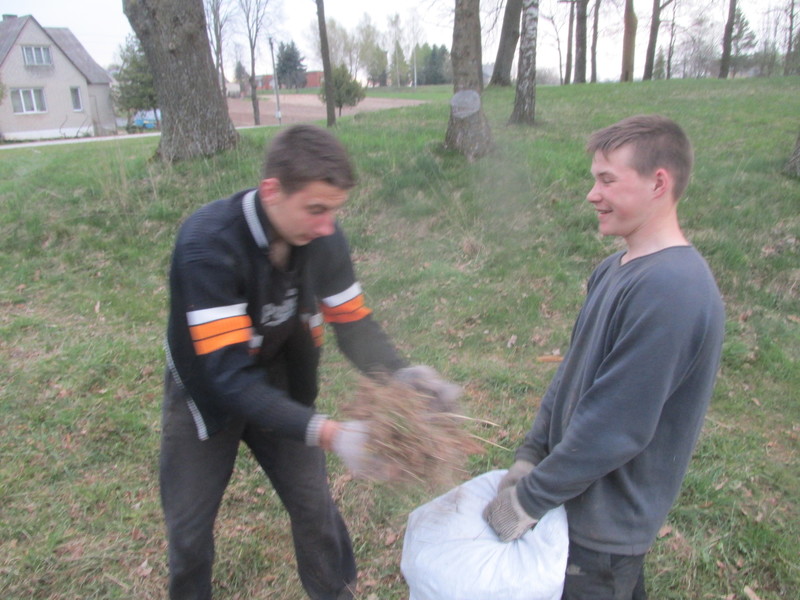
I am a person of outrageous ambition, much more like Vytautas the Great than the average Lithuanian. Since childhood I have devoted myself to know everything and apply that knowledge usefully. I illustrate my philosophical ideas with art projects such as my book, The Truth: From Relative to Absolute. I pray with my neighbors in twos and threes, as Jesus teaches, inspiring all manner of adventures. I hire the youth to renovate my house and yard, which I bought two years ago with money my parents gave. We take breaks to play chess, eat chocolate and sing hymns. I think of my house as a creativity center and my yard as a giant art project.

I happen to live next to a quaint cemetery with few graves visible. There seem to have been a few children buried here, and I have heard, some German soldiers from World War II. Last year the alderman Algirdas Jusas let me have my neighbor Vytas chainsaw a branch that had blocked my view of the large cross which Algirdas Judickas had helped make. I am interested in eternal life, here and now. I like the idea of a bridge unto the afterlife, where we can all travel back and forth. So between my two Caucasus plum trees, which are blooming now, I imagine an elevated walkway, like a pier, heading out onto the cemetery, which looks like a giant cathedral with four trees as columns, and the large cross in view. At times, the pier could become a bridge. So now I seem to have sacred planks for the walkway and bridge, the floor boards which the Jewish scissorman’s family walked on, both upstairs and downstairs.
I also have some pieces of planks that were sawed up. I want to paint these in the different colors — black, white and the entire rainbow — and use them as stepping stones for the path which the youth tread to my house.
I will talk with Darius what to do with the giant beams. These are a real treasure and we’ve protected them with plastic from the rain.
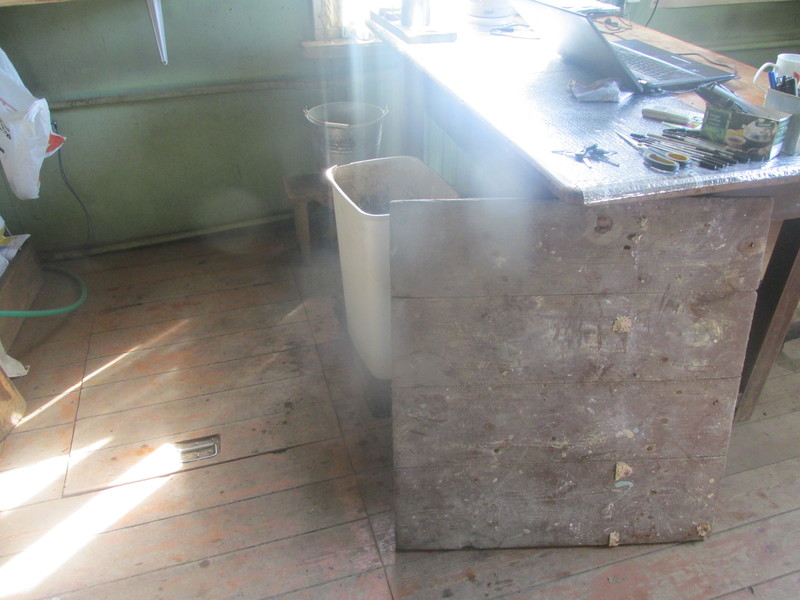
The square cover to the cellar gives me pause. It just so happens that I have a very similar cellar door which I need to shorten or move 20 cm to make way for my new kitchen sink. If I were to keep the square cover, then I would incorporate it here, which is a practical way of preserving it. The hideout would thus become part of the lore of my house, my center. The only problem is that I would add a handle and a hinge, which are conveniences that cut against the truth of its original use. Still, it may be more meaningful here, with a real live person, the kind who might risk his life to hide Jews, then tucked away in some museum in Vilnius, or even on display in an artificial malina, where they could show a replica.
On Sunday, I encouraged Daina and Artūras to wait until I published this article and we heard from readers. It would be unfortunate if they rushed with the renovations.
Monday night, I tried to call Daina to stay in touch, as Darius encouraged me. She didn’t answer. Darius called me to say that it was all in vain. His sister was having it all cemented the next day.
Darius was frustrated. He kept falling back on his word “women”: “bobos”. I had told him that he might do better with his sister if he didn’t use that word. Although when I heard her call herself “sena boba” I asked her about that. She confirmed that in Žemaitija it wasn’t quite perjorative as it was elsewhere.
Tuesday morning, while finishing this article, Daina emailed me to say that my article “How Did Lithuanians Wrong Litvaks?” was interesting, especially the presentation. I understood that she understood me, the one who “loves to investigate genocide,” as she likes to say. I called her and she confirmed that she and Artūras were going ahead with their plan to cement over the cellar. They knew a museum curator Kostas who said this was a good idea. People would know about the cellar and when the time has come it could be revealed. I felt good that they were thinking ahead perhaps ten or twenty years. I also appreciated that Darius’s passion had influenced his sister surely more than he could know.
I hope to see Dovid Katz here soon. I’m wondering what to do with the cellar cover, the giant beams and even the planks, hoping that twenty years from now they will return to their true home, perhaps with more stories along the way.

I’m reminded of what Jesus said about what is “mine”: “This bread is mine. It is thus intended for me to eat it, for it to become my body. Now suppose I decide otherwise. I give it to you. Then you are eating my body.” Which is to say that to give something up is to have it, have each other, even more so. We have room for invention.
I ask for your thoughts on what I should do with my share of Jewish heritage?
As for Butrimonys, we can strive for good relations, for understanding each other, even without any Jews left here. I believe that God will reward our efforts with Jews who visit, stay and live here.
Andrius Kulikauskas, PhD (ms<at>ms.lt), is a philosopher, artist, writer, educator, organizer and the author of “The Truth: From Relative to Absolute.”
